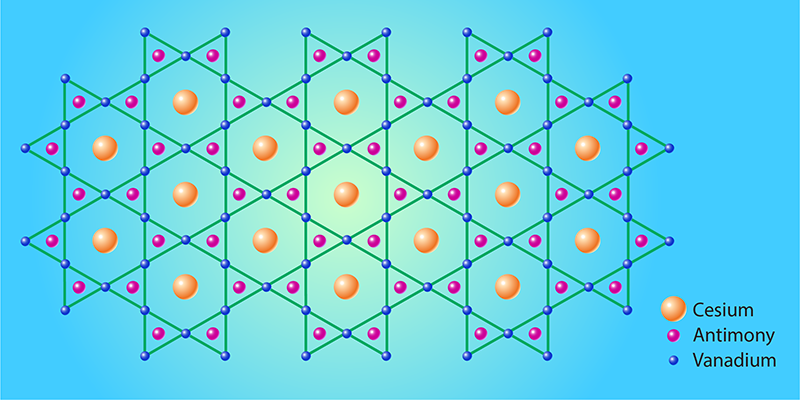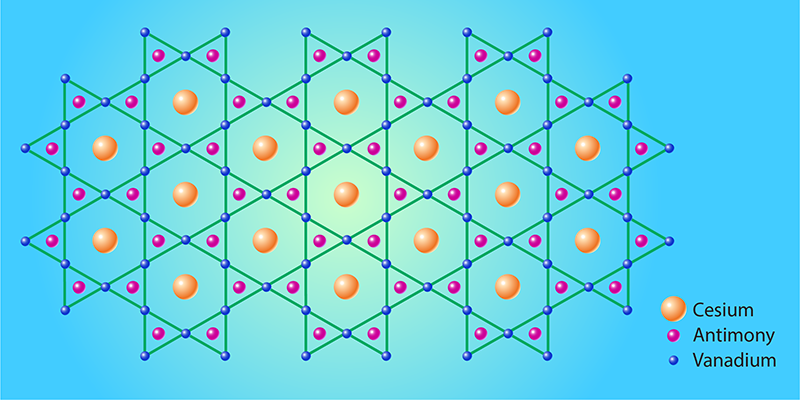Cooper Pairs Pair Up in a Kagome Metal
A kagome crystal features two-dimensional atomic layers whose structure resembles a traditional Japanese basket weave called kagome. For several decades, the kagome crystals that attracted the most attention were insulating magnets. The geometric frustration inherent in their kagome structure could, it was hoped, engender a much-sought exotic state known as a quantum spin liquid. By contrast, the metallic side of the kagome family was more of a theoretical curiosity. That status changed in 2019 with the discovery of exotic electronic behavior—Dirac fermions and flat bands—in the kagome metal FeSn [1]. A bigger surprise followed a year later when superconductivity was observed in the kagome metal cesium vanadium antimonide (CsV3Sb5, or CVS for short) [2]. Now a team led by Jian Wang of Peking University has reported that a kagome crystal displays a unique phenomenon for conventional superconductors: the emergence of quasiparticles with an electric charge 4 and 6 times that of an isolated electron [3]. The finding challenges the expectation that electron binding forces grow substantially weaker with the number of involved electrons, which could pave the way to uncovering new forms of superconductivity.
Superconductivity occurs when electrons form Cooper pairs, effectively doubling the charge of the electric carrier in the superconducting state. This doubling has a direct ramification in experiments that exploit the Aharonov-Bohm effect—the acquisition of a quantum-mechanical phase when a charged particle completes a loop in a plane perpendicular to a magnetic field. For single electrons, the phase causes physical signals to oscillate periodically whenever the magnetic flux through the system changes by a flux quantum of h/e. In a superconductor, the charge doubling leads to a halving of the flux periodicity—a telltale manifestation of Cooper pairing. Indeed, William Little and Ronald Parks’ 1962 observation of the halving [4] was among the first to demonstrate Cooper pairing, which is an essential ingredient of the Bardeen-Cooper-Schrieffer theory of conventional superconductivity.
In their experiment, Little and Parks shaped an insulator (a commercial varnish) into a cylinder and coated it with a layer of a superconducting material (tin). In the presence of an adjustable magnetic field, they observed periodic oscillations in the resistance near the superconductor’s critical temperature Tc as the flux through the cylinder changed by h/2e rather than h/e.
Wang and his collaborators’ experiment on CVS is an adaptation of the Little-Parks experiment. The researchers deposited CVS onto a substrate to form a thin layer. Their sample had a hole in the middle, so that electrons or Cooper pairs were compelled to go around the hole (either clockwise or counterclockwise) and experience the Aharonov-Bohm effect. Bulk CVS has a Tc of 2.5 K. However, the resistivity of the CVS layer started to drop at about 4 K and vanished at about 1 K. Such a gradual drop in resistivity starting well above the bulk transition temperature is expected for a thin superconducting compound, marking a “fluctuating regime” of superconductivity where Cooper pairs are present in a disorganized fashion. One might have expected charge-2e Cooper pairs to persist even up to 4 K, giving rise to h/2e resistance oscillation. Instead, the researchers observed evidence of oscillations at the flux period of h/6e between 2 and 3 K and of h/4e between 1 and 2 K, with the h/2e period becoming dominant only in the zero-resistance regime below 1 K.
The h/6e and h/4e periodicities might imply the intriguing possibility that two or three Cooper pairs somehow coalesced into “Cooper molecules” with a 4e or 6e total charge. Theories predicting such a surprising possibility have been around for some time, notably, for so-called Fulde-Ferrell-Larkin-Ovchinnikov (FFLO) superconductors [5]. In FFLO superconductors, the Cooper pairing takes place between electrons having momenta Q/2 + k and Q/2 – k, with a net momentum of Q for the pair. By contrast, ordinary Cooper pairing takes place between electrons of opposite momenta k and –k, with zero net momentum. In the presence of hexagonal crystal symmetry, three types of FFLO orders are possible. As the temperature rises beyond Tc, the individual ordered states may melt away, but a composite order may survive, according to the theoretical predictions. This state has quasiparticles with charge 6e and could explain the h/6e resistance oscillation that Jian and his colleagues observed. Support for that explanation comes from experiments, backed by theory, that pointed to a feature in the band structure of CVS involving six valleys, or Fermi pockets, arranged in momentum space with a 60° angle between them [6]. Composite order—more popularly known as vestigial order—has become a fruitful framework for understanding the complexity of quantum materials based on symmetry [7].
A potential wrinkle in the new CVS experiment is that, unlike the original Little-Parks setup, the magnetic field not only penetrates the hole in the middle of the superconductor but also the entire material. Defining paths for the Aharonov-Bohm effect under such situations is problematic, and it hampers the precise determination of the flux periodicity. Patrick Lee of the Massachusetts Institute of Technology and I argued that these higher-charge Cooper pairs are capable of “sniffing out” the most efficient path, which happens to be the one circling around the boundary of the hole in the middle of the sample [8].
Clarifying the role played by the complex Fermi-pocket structure in stabilizing the vestigial superconducting order—and thus the higher-charge Cooper-pair state in the superconductor—is a direction to pursue in the future. What do the Cooper pairs look like as they orbit around each other in molecules? Until now, no one has given much thought to this question, but figuring out the “shape” of these composite quasiparticles could hold the key to a full understanding of vestigial superconductivity. Scanning tunneling probes might soon provide such a characterization.
Acknowledgments
Jung Hoon Han acknowledges Patrick Lee of the Massachusetts Institute of Technology for helpful comments on the article.
References
- M. Kang et al., “Dirac fermions and flat bands in the ideal kagome metal FeSn,” Nat. Mater. 19, 163 (2019).
- B. R. Ortiz et al., “CsV3Sb5: A Z2 topological kagome metal with a superconducting ground state,” Phys. Rev. Lett. 125, 247002 (2020); R. Berkowitz, “A 2D metal compound shows a superconducting surprise,” Physics 13, S152 (2020).
- J. Ge et al., “Charge-4e and charge-6e flux quantization and higher charge superconductivity in kagome superconductor ring devices,” Phys. Rev. X 14, 021025 (2024).
- W. A. Little and R. D. Parks, “Observation of quantum periodicity in the transition temperature of a superconducting cylinder,” Phys. Rev. Lett. 9, 9 (1962).
- D. F. Agterberg et al., “Conventional and charge-six superfluids from melting hexagonal Fulde-Ferrell-Larkin-Ovchinnikov phases in two dimensions,” Phys. Rev. B 84, 014513 (2011).
- S. Zhou and Z. Wang, “Chern Fermi pocket, topological pair density wave, and charge-4e and charge-6e superconductivity in kagomé superconductors,” Nat. Commun. 13, 7288 (2022).
- R. M. Fernandes et al., “Intertwined vestigial order in quantum materials: Nematicity and beyond,” Annu. Rev. Condens. Matter Phys. 10, 133 (2019).
- J. H. Han and P. A. Lee, “Understanding resistance oscillation in the CsV3Sb5 superconductor,” Phys. Rev. B 106, 184515 (2022).





